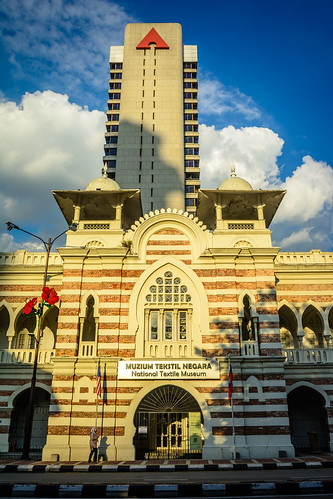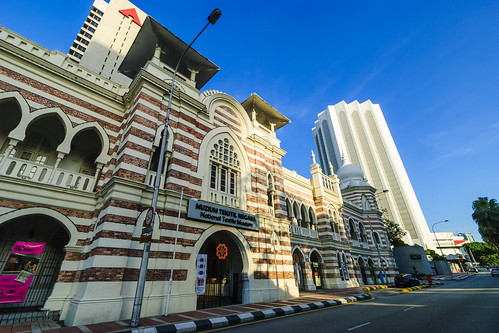FMS Railway Service Central Office - the current National Textiles Museum
 |
| The former FMS Railway Administration Central Office. Currently National Textile Museum |
Federated Malay States, the predecessor of Malaya (now Malaysia) experienced rapid development under the British Colonial Government before the first World War thanks to market boom of tin and rubber - two main exports of Federated Malay States.
After introducing the first railway line to British Malaya in 1885 from Taiping to Port Weld to transport the tin ore, Kuala Lumpur had its first railway service in 1886 when the railway service from Bukit Kuda in Klang to Kuala Lumpur was started by Selangor Government Railway. It was reported that the first train was hauled by the locomotive named "Lady Clarke", an ex-Indian Railways B class locomotive.
The picture above shows the first building that housed the head office of Selangor Railway Service which was likely completed in 1895.
Interestingly, according to a reliable research done on Arthur Benison Hubback on a page entitled Government Offices, Kuala Lumpur: The 1893 Proposal if the British Colonial Government were to approve the first design scheme proposed by Public Works Department (PWD) for Government Offices (now Sultan Abdul Samad Building) in Kuala Lumpur, it would have looked like what is shown in the drawing signed off on 1 July 1893 by CE Spooner, the State Engineer of Selangor PWD as below.
 |
| Image reproduced from https://www.abhubback.com/ |
The above sketch includes proposals for the Sanitary Board (far left), the Gombak Bridge and the Railway Station (far right). This Neo Classical row was designed by the Selangor PWD State Architect, Arthur Charles Alfred Norman and Chief Draughtsman, Regent Alfred John Bidwell.
However only the design of Gombak Bridge and the Railway Offices in this scheme that was built. The close-up of the drawing of the Railway Service Central Office is shown below.
 |
| Image reproduced from https://www.abhubback.com/ |
Although this Railway Offices was built in 1895, it was later demolished beginning of May 1904 to make way for AB Hubback's 1905 FMS Railways Central Offices.
J.M. Gullick in his book, A history of Kuala Lumpur 1857-1939, wrote that the piece of land where the current National Textiles Museum stands had been allocated to the use of the railway since the line first reached Kuala Lumpur in 1886, the main goods yard extended to the southeast from the corner of Market Street and Jalan Sultan Hishamuddin, and the first railway station was at the corner itself.
Gullick further stated:
At some time, not earlier than 1892 when the second railway station was built further south, an unpretentious L-shaped block of railway offices were built on the station site, alongside the main exit (into Market Street) from the goods yard - no doubt a convenient point for the collection of railway dues etc. Then in 1901 the merger of the Perak, Selangor and Sungei Ujong (now Seremban) state railway lines to form the FMS Railway system (which was expanding rapidly north and south) made necessary a larger railway headquarters office - still on the same site.As a result of the merger that led to the existence of the Federated Malay States (FMS) Railway Service, a new and larger building was planned to be built on the current site - the corner of Market Street (now Lebuh Pasar Besar) and Victory Avenue (now Jalan Sultan Hishamuddin). It is also the very site where the first ever Kuala Lumpur railway station was seated which according to JHM Robson in his book, Records and Recollections (1889-1934), was "little more than a glorified shed".
Arthur Benison Hubback, the Federal PWD Assistant Architect was again entrusted to design a new building whose architecture was to adopt the Indo-Saracenic architecture just like The Government Offices (now the Sultan Abdul Samad Building) and the Municipal Office & Town Hall that he previously designed. In fact the FMS Railway Service Central Office was the third building designed by AB Hubback in Indo-Saracenic style.
The design was completed in 1902 but the construction was said to have started only in 1904. It was not known why the construction started only in 1904 but I suspect they needed some time to demolish the previous single-storey building.
The construction project of this elegant edifice was awarded to Towkay Ang Seng Moi and the cost of construction was reported to have been $116,122 Straits Dollars. The construction was completely finished in May 1905 together with the gate fence of the railway Marshalling Yard.
This two and a half storey building occupies an area of 3259 sq. metre while having a floor area of 3145.3 sq. metre. The prominent features of this handsome edifice, among others, are its external walls featuring salmon red and white bands resulting from alternate bare brick and white plaster bands, the corner stair tower accentuated by a dome rising from a base surrounded by mini domes and its main entrance fronting on to Jalan Hishamuddin is flanked by two pylons each topped by a chhatri.
 |
| The main entrance facing Jalan Sultan Hishamuddin is flanked by two pylons each topped by a chhatri |
Other than that, along its loggia on both floors, the pointed horse shoe arches running along the building provide shade against sunlight and airy atmosphere - the Indo-Saracenic design adapting to the tropical climate of then Malaya.
 |
| The loggia shaded by pointed horse shoe arches |
This building served as the Central Office of FMS Railway Services from 1905 to 1917 after which it moved to a new 3-storey building which was much larger. It was the then new FMS Railway Administration Building completed in 1917 where Keretapi Tanah Melayu Berhad (Malay for Malayan Railway Limited) is now headquartered.
The 1905 FMS Railway Service building was then taken over by the Selangor Public Works Department in 1917 for several decades. It was later occupied by Bank Negara Malaysia and several other government departments. In the meantime on 13 October 1983 this elegant building was gazetted as a historical building by the Malaysian Government.
It once served as the Appellate Court from 2001 to 2004 before it was renovated in 2007 to be turned into a museum. On 9 January 2010 it was opened to the public as the National Textile Museum until now.
 |
| The former FMS Railway Service Central Office surrounded by the neighbouring high-rise buildings. |
 |
| A rainbow in the late evening after the rain |
 |
| The corner of Lebuh Pasar Besar and Jalan Sultan Hishamuddin which is connected to Jalan Raja |
 |
| A double-frontage former FMS Railway Service Central Office |
Enjoy more pictures of the National Textile Museum here.
[Updated on 20 April 2020]
REFERENCES:
Arthur Benison Hubback. (2018, January 21). Government Offices, Kuala Lumpur: The 1893 Proposal. Retrieved from https://www.abhubback.com/post/government-offices-kuala-lumpur-the-1893-proposal
Chin, K.Y., & Chen, V.F. (1998). Kuala Lumpur, a sketchbook. Singapore: Archipelago Press.
Gullick, J.M. (2000). A history of Kuala Lumpur 1857-1939. Kuala Lumpur: MBRAS
Pictorial history of railways around Kuala Lumpur. (2010, November 2010). Retrieved from http://searail.malayanrailways.com/Selangor/Selangor%20Early%20pictures.htm
Robson, J.H.M. (1934). Records and Recollections. (1889-1934). Kuala Lumpur: Kyle, Palmer & Co.

Were you reading Architecture in Oxford around late 1975 .... and 1976/77 ?
ReplyDeleteAnd you and your wife had a pair of infant twins ?
--------------
No, I am afraid that's not me. Anyway thanks for visiting my blog :)
Delete